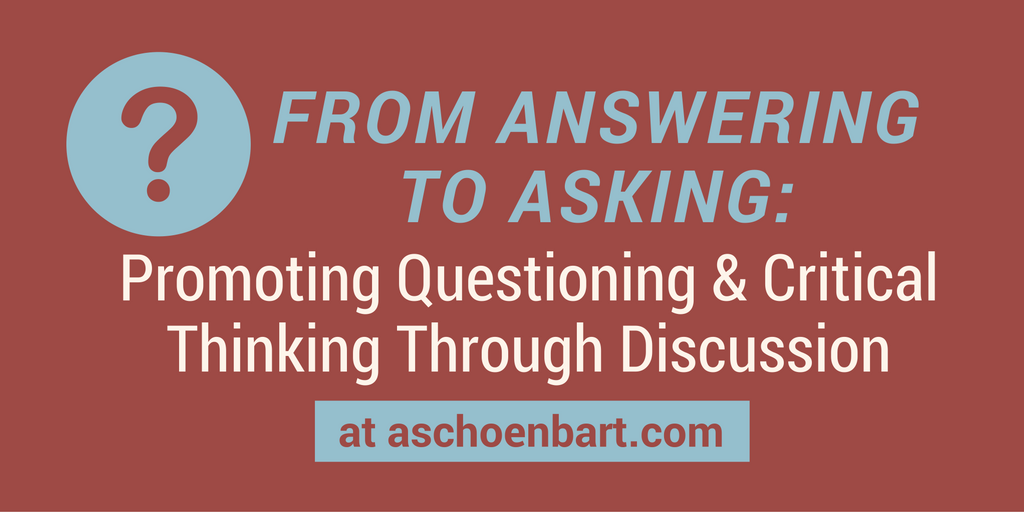From Answering to Asking: Promoting Questioning & Critical Thinking Through Discussion


My students are pretty good at answering questions, but they aren’t always great at asking them. Questioning is a hard skill, involving critical thinking, creativity, and inquiry. Simply put, we don’t do enough to teach students how to ask good questions. At least I don’t.
After watching groups of students awkwardly flail in silence in lieu of meaningful Socratic discussion and questioning, I realized this dilemma: how can we expect student to ask high level questions to promote critical thinking and discussion when school prepares them for the opposite? Too often, our system prepares students to answer more than ask and to consume instead of create.
This year, I’ve made more efforts to promote meaningful student-driven discussion, and I explored some of those idea through blended learning in articles like Blending Discussion: Using Technology to Enhance Student Voice & Audience.
This week, I continued that exploration through a three-day Socratic process to help students develop discussion and questioning skills. It was rewarding and enlightening, and revealed some major areas of growth to work on throughout this year.
Overview
To conclude our study of Elie Wiesel’s Night, I sought to expand our analysis beyond the book to the world today, as well as to promote student voice and empowerment. Throughout the three days, students spoke more and I spoke less, and students drove the discussion--to both great success and awkward silence. Each day, the students were asked to return to the texts and to continue to provide evidence to support their ideas. Find the slides and questions for the week here.
Day 1: Class Discussion
On the first day, we circled up and discussed questions that the students had. What haven’t we discussed enough in the text? What questions still remain? How does Wiesel’s character, purpose, or style change throughout?
This day focused mainly on analysis and closure for the text before we expanded to bring in more texts. Then, students helped me find current events articles related to the ideas of persecution, oppression, injustice, and silence.
Tools and ideas to transform education. Sign up below.
Day 2: Socratic Seminar
Next, students read and annotated their selected articles to prepare for another layer of instruction. I chose three articles from the students’ findings, and assigned each one to five students, and provided the questions to drive today’s discussion.
In class, students used the first five minutes to review their annotations, articles, and the questions to prepare for discussion. We discussed the following questions:
- What would Elie Wiesel say about the world today?
- Has the world changed?
These open ended questions led to discussion of the texts, the memoir, and our world in new and interesting ways.
Day 3: Fishbowl & Backchannel
Now came the real challenge: to get students to ask the questions. We again circled up, this time with an inner and outer circle. The Tweet above shows some pictures of our setup. In the inner circle, students discussed their articles from the previous days, and all students in the circle read the same article. I had provided some tips for generating good Socratic-style questions and stem starters previously, but didn’t guide the discussion in any way. I didn’t even talk.
In the outer circle, students used Today’s Meet as a backchannel. I participated here with the students, as we discussed the articles, interesting quotes, and responded to the inner conversation. After 7-10 minutes, the groups rotated positions. And it was a glorious mess.
Some of it was sophisticated, high level discussion. Some was awkward silence and blank stares. But for now, that’s okay.
Next Time
At the end of the first awkwardly quiet group, we discussed the awkwardness, in my only interjection of the period. We talked about how weird it is to sit in the middle of the room and how hard it is to ask questions. I assured students that it would get easier and that we would keep working on these skills, so I hope that diffused some tensions.
When I asked students for good reflection questions for tomorrow, one student wrote: How awkward your conversation was and how well you made an effort to try and bring it out of the awkward stage.
Next time, I want to add a layer of small group discussion to lower the stakes. I want to set clearer expectations for developing questions and what good preparation and participation looks like. And most of all, I want to find more ways to engage the quiet, reluctant, and resistant students.
The learning, discussion, and analysis this week showed progress. In a few months, I’m sure I’ll write about these ideas again, and hopefully we will all do better.
How do you promote meaningful questioning and discussion in your classroom? What strategies do you use to engage all learners? Share your thoughts in the comments or on Twitter @MrSchoenbart.
cross posted at www.aschoenbart.com
Adam Schoenbart is a high school English teacher, Google Education Trainer, and EdD candidate in Educational Leadership. He teaches grades 10-12 in a 1:1 Chromebook classroom at Ossining High School in Westchester County, NY and received the 2014 LHRIC Teacher Pioneer Award for innovative uses of technology that change teaching and learning. Read more at The SchoenBlog and connect on Twitter @MrSchoenbart.
